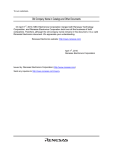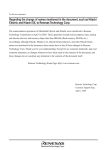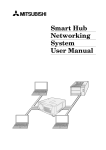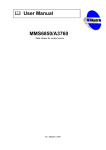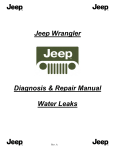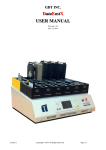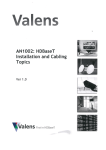Download USER GUIDE SHORE POWER SYSTEM
Transcript
USER GUIDE SHORE POWER SYSTEM 230 VAC 2 30 VAC FU SE HOT W: CHARG ER Disclaimer Nord West Marine provides this publication as is without warranty of any kind, either express or implied, including but not limited to the implied warranties of merchantability or fitness for any particular purpose. Further, N.W.M. reserves the right to revise this publication and to make changes from time to time to the content hereof, without obligation to N.W.M. its local representatives to notify any person of such revision or changes. Some jurisdictions do not allow disclaimers of expressed or implied warranties in certain transactions; therefore, this statement may not apply to you. Limited Warranty N.W.M. warrants that the Shore Power System will substantially conform to published specifications and to the documentation, provided that it is used for the purpose for which it was designed. N.W.M. will, for a period of twelve (12) months from date of purchase, replace or repair any defective system, if the fault is due to a manufacturing defect. In no event will N.W.M. or its local representatives be liable for direct, indirect, special, incidental, or consequential damages arising out of the use of or inability to use the Shore Power System, even if advised of the possibility of such damages. N.W.M. or its local representatives are not responsible for any costs, loss of profits, loss of data, or claims by third parties due to use of, or inability to use the Shore Power System. Neither N.W.M. nor its local representatives will accept, nor be bound by any other form of guarantee concerning the Shore Power System other than this guarantee. Some jurisdictions do not allow disclaimers of expressed or implied warranties in certain transactions; therefore, this statement may not apply to you. Document version 1.00 1-2 INDEX 1. INTRODUCTION...........................................................................................1-4 2. THE CENTRAL.............................................................................................2-5 3. SHORE MAINS PLUGG ...............................................................................3-6 3.1 3.2 3.3 Recessing the SHORE MAINS PLUG.................................................................................. 3-6 Drainage ................................................................................................................................. 3-7 Earth connection. ................................................................................................................... 3-7 4.1 4.2 4.3 Types of Sockets .................................................................................................................... 3-8 Mounting of Sockets for hided interconnecting cables ......................................................... 3-9 Sockets in Bath Rooms .......................................................................................................... 3-9 5.1 5.2 Making holes for cables....................................................................................................... 5-11 Plug-In connectors and interconnection leads..................................................................... 5-12 6.1 Mounting of 4. THE 230VAC SOCKETS ...............................................................................3-8 5. THE INTERCONNECTING CABLES ......................................................5-10 6. BATTERY CHARGER ................................................................................6-13 battery charger ......................................................................................... 6-13 7. ELEKTRONICAL WASTE (WEEE) .........................................................7-14 8. CLAIMS.........................................................................................................8-16 1-3 1. INTRODUCTION The boat builder/ workshop is always responsible for taking all necessary safety precautions when installing a Shore Power System. Make sure that the installation is in accordance with the IP level on your system. 230VAC Central 230 VAC 2 30 VAC FUSE HOT W: CHARG ER expandable system Shore Mains Plugg Smart Split Charger, Switch in Central Hot Water, Switch in Central 1-4 2. THE CENTRAL NOTE The distance between the shore plug and 230V central can at maximum be 3m. We offer different cable length up to 3m. Check your system for shore plug cable length before you drill holes/ make recess for the central and shore plug. Install the 230VAC Central in a suitable location. You may use the enclosed template for marking the recess hole. The 230V central shall NOT be installed in following positions: 230 VAC 2 30 VAC FU SE HOT W: upside-down or angled • close to 12V DC distribution panels • open on a side wall • close to heaters or warm objects • close to waste water • or mounted in such a way that the central is easily exposed for physical damage with danger as hazard WARNING The 230VAC central must be mounted so that it cant be opened or hard braking as this constitute a safety hazard WARNING Make sure that screws or drill bits do not damage cables or control units on the back of the panel/wall where the 230VAC central is fitted 3. CHARG ER • 3-5 SHORE MAINS PLUGG NOTE Make sure there is sufficient space in the rear for the cable and enough room for the fastening nuts 3.1 The Shore Plug should be mounted in such a way that it is protected against rain, splash and mechanical damage, and so that the connector lead can be connected without difficulty. If the surface is uneven the attached gasket may be to thin to create a waterproof connection. If so, use a extra gasket or foam as Sikaflex marinegrade to seal the joint. Recessing the SHORE MAINS PLUG NOTE Be careful when drilling/ cutting the hole, so that mounted components, cables etc. are not damaged The gasket may be used as a template for cutting the hole for the shore plug. Place the gasket carefully where you want to mount the mains plug. Use a pencil and draw a picture of the gasket. Make the hole for recessing the shore mains plug. The SHORE MAIN plug shall be mounted so that the cover is hinged horizontal. The plug must not be fitted with the cover hinge pointing downwards. 3-6 3.2 Drainage The Shore plug must be fitted with the hinges straight upwards this so that the drain hole leans downwards. This for allowing condensation and e.g water to be drained away. 3.3 Earth connection. The earth connection (yellow-green-multi core cable with ringshapedcable shoe) MUST be connected to a good earth point on the DC Negative of the boat. Paint, underseal etc. MUST be removed from the contact point of the earth 230 VAC connection. A toothed washer shoud be used both under the screw head and between the cable shoe and the earthing point. 2 30 VAC Eart Wire outlet from Central FU SE HOT W: CHARG ER 3-7 4. THE 230VAC SOCKETS The 230VAC sockets must be placed in accordance with the harmonized standards for the market the boat is going to be sold /used in. 4.1 Types of Sockets The standard Shore Power Sockets comes in IP class 40 and 44. Please check your supplied sockets and make sure that they are as ordered and suit your aria of use. Please contact local autorities if you are unsure about your local IP requirements. For the Scandinavian marked, the Sockets of IP class 40 is intended for use in dry areas as saloon and cabins. Please note that if you have a boat with sun roof, the cabin can not be clasified as dry. The Sockets marked IP 44 are ‘splash proof’ and can be usen in the engineroom, kitchen area, and can be used in bath room if its protected against direct water jet from shower. WARNING The 230VAC sockets must be mounted so that its protected against splash or water jet and any type of mecanical damage with danger or hardbreak as reult. Do no open or brak as this constitute a safety hazard 3-8 4.2 Mounting of Sockets for hided interconnecting cables NOTE Be careful when drilling/ cutting the hole, so that mounted components, cables etc. are not damaged NOTE Make sure there is minimum 5cm space behind the Socket for models with cable mounted with direction straight back. 4.3 The standard shore sockets comes in IP class 40 and 44. Please check your supplied sockets and make sure that they are as ordered. Recess the hole for the socket carfully. Please make sure that the space behing the socket is sufficient for the cable Avoid bending the cable to much. Minimum clerance to Socket back is 5cm. Sockets in Bath Rooms Before mounting Sockets in Bathroom make sure that you have your Local regulations available. For installations in boats for the Norwegian market you shall mount the socket 60cm or more away from the shower cabinet, if you want to mount the socket lower than 170cm from the floor. WARNING The 230VAC sockets must be mounted so that its protected against water from the shower. 3-9 5.THE INTERCONNECTING CABLES If the interconnecting cable must pass a wall etc, be careful when drilling holes to pass through the Plug-In cable. NOTE Be careful when drilling/ cutting the hole, so that mounted components, cables etc. are not damaged When passing the Main Shore plug to the central, and from the central and to the sockets, charger, water heater, and to other users. take extraordinary care that the interconnecting cables are, and will not be, exposed for damages. If the cable has to pass through holes, etc, with sharpe edges, the interconnecting cable must be insulated against mechanical damage. It is strongly recommend a rubber bushing and seal the hole This must be performed in a way that secure the insulation to last and not to brake. There is also supplied a cable protection coat for extra protection against mechanical damage when use in hash environments. WARNING Route the cables straight away from the contacts on the Smart Split, Rout the cable as streight as possible from the plug in users so the contacts are not bent or twisted 5-10 5.1 Making holes for cables A Ø25mm hole saw is a particularly suitable tool for this task. Make sure that the tool does not damage fitted components, brake lines, electrical cables etc. To seal the holes and to protect against mecanical damage use e.g a rubber bushing to seal the hole. Make sure the rubber bushing is fitted properly. 1 Interconnecting cables should slope downwards from the passing through point into the cabin compartment (1) so that water or humidity does not run along the cable into the cabin. If passing through dirty arias clean the surfaces carefully with a suitable grease solvent, for instance Acrysol. Do not use acetone, trichlorethylene, Breakclean or similar products as PVC and plastic may be damaged. 5-11 5.2 Plug-In connectors and interconnection leads. It is important when connecting the leads to press the contacts together sufficiently hard for the O-ring on the male contact to seal properly. Make sure the O-ring is not pushed out of the groove when pressing the contacts together. Fasten the interconnection leads with plastic strips on cable gates or in suitable spots. Do not lay 230V Cables close to 12V cables without special labelling. Contact N.W.M. for further information in this case. Special care should to taken in the engine compartment. Keep cables well away from sharp, hot, wet or moving parts. PRESS to LOCK PRESS to OPEN Safety Lock WARNING It is importation when connecting the leads to press the contacts together sufficiency hard for the safety lock to lock properly, and so the O-ring to seal properly. Do not MIX 230VAC cables and 12V DC cables 5-12 6. BATTERY CHARGER When use of a charger not supplied from N.W.M, nor equipped with N.W.M.’s special safe plug in connectors, connection the battery charger via a standard shore Power socket as shown from the manufacturers wiring diagram. Connect the battery charger in accordance with the diagram attached with the charger. All other connections will be treated as illegal. In such case the system safety and system warranty in not valid. 6.1 Mounting of battery charger NOTE Avoid charging batteries in a closed area, as there is a potential danger of explosion. Mount the battery charger in accordance with the attached battery chargers user guide. Make sure the battery charger is not placed too close to hot parts such as engine or engine exhaust pipes. READ battery charger User Guid before mounting. For connections from the Battery Charger to the Battery, always read the Battery Chargers User Manual Carefully Connection to the battery must always be made with the enclosed fuse. For Retronic Chargers, see specific Battery Charger Mounting Instruction. 6-13 WARNING The temperature of the battery may not exceed +40ºC during charging. WARNING The charger contains high voltage current. Therefore do not use a drill on it or open it. 7. Elektronical Waste (WEEE) The use of WEEE symbol indicates that this product can NOT be treated as ordinary household waste. To protect the environment make sure that this product is not delivered through a ordinary bin If you are unsure, please contact your local authorities for guidance regarding special waste and recirculation of this type of product. 7-14 Technical Spesifications Central /(Standard): 16A Dual Fused 30mA RCB 2 16A Switch ON/OFF circuits Standard text: Hot Water-Charger Other text on request Number of circuits, functions etc. on request WE CUSTOMIZE ALL ON REQUEST Cables: 1,5mm2 and 2,5mm2 With or without extra protections Standard: 1-2-3-4-5-7 m length Other on request Sockets: Standard Scandinavian model Standard IP 40 and 44 Others on request Single, Dual and Combined 12/230 All types on request All country models on request Main Inlet Plug/ Cable Stainless Steel Waterproof IP67 16A/ 2,5mm2, Yellow-Marinegrade 25m with interface cable to Scandinavian output feed. Thank you for using Nord West Marine as SHORE POWER SYSTEM 7-15 8. Claims Claims may not be made for damage resulting from: Normal wear and tear Faulty installation Lack of maintenance and faulty or irresponsible use The use of non-original connectors/leads or use together with non-original parts Modification or repairs of the product, or attempts thereon, carried out by others than N.W.M. without written authorization by N.W.M to carry out such modification, or repair conditions after delivery beyond the control of N.W.M. 8-16
















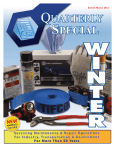
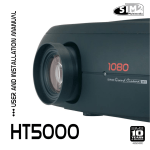
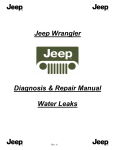
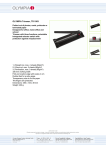
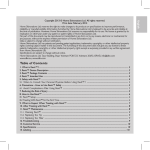
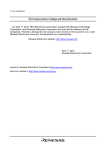
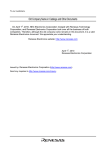
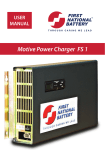

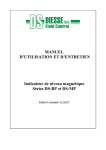

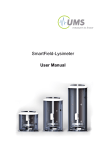
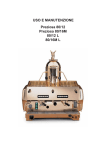
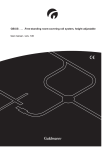
![Instrucciones Manipulación / Handling Instructions [ GENERAL ]](http://vs1.manualzilla.com/store/data/006270185_1-23c4fc4371ee2eaf6e3051f14a7d6232-150x150.png)
